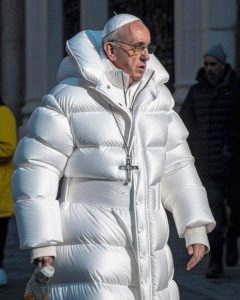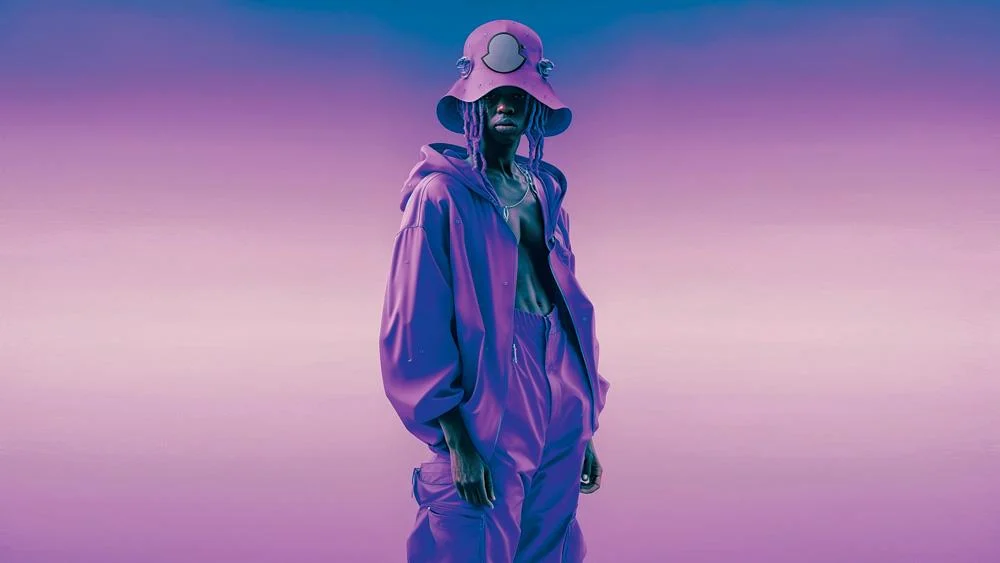Interview for Feeling : How artificial intelligence is conquering the fashion world
Feeling, August 10th, 2023
The pope in a puffer jacket? How artificial intelligence is conquering the fashion world
Chatbots that do your homework, deepfake interviews and computer-generated pop songs: AI is everywhere. And the fashion world is also eagerly jumping on the fully automatic bandwagon. Will artificial intelligence soon make designers and models of flesh and blood superfluous, or can man, machine and fashion exist in harmony?
In the fashion world, people are rarely surprised by an unusual look. Actor Jared Leto in a photorealistic cat suit? Yawn. Beyoncé in a UV-reactive stage outfit that changes color? Been there, done that. And yet some strange faces have made us stare at our screen in amazement over the past few months. Was that the pope as a hypebeast in an oversized puffer jacket? Will the entire Harry Potter cast, including Voldemort, star in the new Balenciaga campaign? Before you question the power of your Tom Ford glasses: the images described above are not real, but the work of generative AI, or artificial intelligence.

In 2023, fashion seems to be largely about generating memes and moments with cultural impact. Well, to put it in internet jargon: AI is the moment. After NFTs and the Metaverse, “artificial intelligence” is the latest buzzword in the world of technology and beyond. However, for every fashion house that comes up with an AI campaign, there is an artist or designer who sues for virtual plagiarism. Artificial intelligence is based on machine learning (see AI for dummies) and learns to recognize and predict patterns based on previous data. Show an AI application 100 dresses and your computer will spit out what looks like a dress. Show that same AI application a thousand or even ten thousand dresses and your frankenstein design – a new creation that builds on pre-existing images – can rival the work of a real, maybe not very original, designer.
Old technology in a new (puffer) jacket
That may sound futuristic, but AI is not new. The technology has been around since the 1950s and chances are you use it every day. Virtual assistants such as Siri and Alexa, smart cars and smart vacuum cleaners, the recommendations you get from Spotify and Netflix, are all based on AI. What is new is the speed with which everything evolves. For example, the internet is flooded with uncanny images, created with AI applications such as DALL-E and Midjourney. Those image generators convert a textual description, or prompt, into an image. The more detailed the prompt, the more realistic the end result, with the result that real and fake are increasingly difficult to distinguish.

For example, US celeb Chrissy Teigen tweeted: “I thought the pope’s puffer coat was real and didn’t think twice about it. No way that I will survive the future of technology.” Teigen isn’t alone in her concerns. Computer scientist and AI pioneer Geoffrey Hinton himself recently sounded the alarm about the rapid and unbridled advance of technology. Within the fashion world, as in other creative sectors, people seem to be mainly afraid of job losses and the risk of plagiarism. While those concerns are legitimate, they are not holding back progress. Online trade magazine The Business of Fashion makes the analogy with the Luddites, who destroyed weaving machines in nineteenth-century England as a protest against the industrial revolution: “The Luddites didn’t get very far by destroying machines. In any case, the fashion world will have to start thinking about how to incorporate those tools in ways that take into account the new reality, without leaving workers out in the cold.”
The Emperor’s Clothes
That AI, in addition to dangers, also offers many opportunities within the fashion world, confirms fashion and technology expert Ann Claes: “AI can speed up or improve certain things. You can have a business plan or press text written out by ChatGPT and mood boards can be created faster in Midjourney. I mainly see AI as a tool to improve and optimize your work.” Sketching, pattern drawing, copywriting, grading; the applications are endless.”
Currently, large fashion companies invest the most in artificial intelligence. Claes: “Larger players can switch gears more quickly. For example, Zalando recently launched a ChatGPT application.” This application takes the form of a fashion assistant that guides you through the webshop’s offerings. For example, if you ask ‘What should I wear to a wedding in Santorini?’, the chatbot will know that it is a formal event in a warm climate and will link to relevant items.
Fashion brands use AI not only as a personal shopper, but also as a creative director. The Spanish Stradivarius, sister of Zara, put its spring collection through the AI mangle and created dreamlike images in which virtual models wear floral blouses that don’t really exist. According to the brand, it is “an exaggeration of the collection that reflects what fashion could be if reality did not limit us”. Creative freedom or consumer fraud? Online shoppers can, of course, view the existing collection before pulling out their credit card. This way you avoid buying an artificial cat in a bag. In the luxury segment, virtual campaign image and real garment are closer together. For example, M3GAN, the AI killing machine from the horror film of the same name, wears an almost sold-out hoodie by Heaven by Marc Jacobs and the creations from Moncler Genius’ AI campaign in collaboration with Adidas and Alicia Keys walked the catwalk during London Fashion Week at the end of February. The emperor’s new clothes are now on sale.

Metamodels
Leaving aside the Moncler show, AI fashion is often worn by AI models. They populate digital parades and are increasingly popping up in the world of e-commerce. Levi’s recently announced that it would be teaming up with Lalaland, a Dutch tech company that develops software that brings virtual, but extremely realistic-looking models to life. Founder and CEO Michael Musandu, born in Zimbabwe and based in Amsterdam, started his company from a personal loss: “I never felt represented as a person of color when shopping online. Like any good technology enthusiast, I decided not to wait for the future, but to create it myself through artificial intelligence. With Lalaland we want to make webshops as diverse as the market they serve. We do that by supplementing traditional photography with AI-generated models.”
Major brands such as Levi’s and smaller labels such as the Dutch Ophilia use Lalaland’s software to create models in every possible size and skin color. That seems inclusive, but critics argue that real models with a diverse look are losing jobs because of this revolutionary cost-cutting campaign. The phenomenon is called ‘digital blackface’: the online appropriation of black images by non-black people. Musandu contradicts that: “Brands that take inclusion seriously will continue to hire diverse models, but it is impossible for them to shoot every look on nine different types. Thanks to our software, this is possible and you get an even better representation. In addition, we have created a completely new earnings structure for minority groups. They can license their data – say, images of their hair or hands – as one-off training material for our AI application. There will always be a need for real models to make an interpersonal connection with consumers and drive traffic to a webshop. An AI model can never compete with that.”
Anyone designer?
While international retailers are investing massively in the new technology, things are not going that fast in our country yet, according to Claes. “If I ask a hundred designers if they work with AI, a dozen may say they have already experimented with it and only a handful actually use it in their creation process.” AI is more popular among young Belgian creatives. After all, thanks to programs such as Midjourney, even people without a fashion background can conjure up amazing designs from their hats – with some IT knowledge or self-study.
“The available AI tools are more user-friendly than ever, so more and more people are using them.” Jerry Galle, artist and researcher affiliated with the AI lab of the School of Arts in Ghent, also sees this democratization: “AI offers incredible possibilities for a starting designer or artist. It is a kind of mirror for everything that floats around on the internet and a search engine within our culture. I think Andy Warhol would have found these developments very interesting.”
The genie is out of the bottle; you can no longer imagine AI without it. It will therefore become even more important for designers to have a clear vision and to curate it.
Ann Claes, fashion and technology expert
In the future, according to Warhol, everyone would be famous for fifteen minutes, but will everyone with a computer and internet connection be allowed to call themselves a designer in the same future? According to Shayli Harrison, the answer is twofold. The Australian graduated from the Antwerp fashion academy in 2018 and makes digital couture, or 3D assets, that your avatar can wear in games and the Metaverse. “If you’ve designed something in DALL-E and you want to call yourself a designer, go ahead, but fashion is more than pretty pictures. Being a designer also means having a critical eye and developing your own aesthetic. In addition, fashion is an applied art; you still have to apply them.” Claes also agrees: “There is a big difference between creating a beautiful image for your Instagram and actually creating physical production. This requires a lot of other skills that AI does not have.”
Fashion vs. machine
Even according to its biggest supporters, AI can never completely replace a human being made of flesh and blood, but we should not dismiss the technology as a gimmick. Harrison sees it as a way of thinking outside the box: “It leads to combinations and thoughts that you wouldn’t come up with yourself. I know several designers at major fashion houses who feed AI with existing designs from the brand as input and then see what comes out.” Galle also sees this working method as an interesting avenue for the designers of today and tomorrow: “AI provides visual links that you would not easily make yourself. The only drawback when working with existing datasets is that it sometimes seems pre-made, like a mash-up of existing images. That’s less exciting from an art or fashion perspective. Only when you re-enter the output and question the system you get an enrichment.”
So we get to the point: can AI-generated fashion, which is by definition based on previous designs, ever be truly original? “That’s a tough question,” says Harrison. “Fashion is cyclical anyway and refers to the past to create something new. In that respect, AI mode is not that different.” Besides being a designer, she is co-founder of Mutani, a company that connects designers with digital makers, helping to translate fashion into an online identity. Together with five other tech savvy alumni of the Antwerp academy, including current director Brandon Wen, she winkingly dubbed herself ‘The Antwerp Cyber-Six’, by analogy with the Six of Antwerp. Simply put, the virtual world is Harrison’s second home. She was therefore very interested in the first AI Fashion Week, organized by creative AI studio Maison Meta in collaboration with American webshop Revolve.
More than four hundred designers from all over the world participated in the very first AI fashion week, from which a professional jury ultimately selected three winners. They will soon have the opportunity to bring their work to life within a tech incubator and launch their collection on Revolve and sister website FWRD. So there remains a place for humans in this fashion world ruled by machines and algorithms. From the as-yet-unknown designers, who weave aesthetic sense and IT skills into original AI designs and guard their prompts as state secrets, to the manufacturers, studio and factory workers who will be required to produce the physical clothing. “I don’t see a complete automation in which an AI application autonomously designs and produces clothing happening,” AI artist and critic Galle reassures us. “Then you are already talking about a conscious AI application and the question is whether you can create consciousness within a binary system. I do not think so.”
Will AI play a lasting role in the future of fashion and the fashion of the future? According to Claes it is: “The genie is out of the bottle; you can no longer imagine AI without it. It will therefore become even more important for designers to have a clear vision and to curate it. Creativity remains the great differentiator and determines what we as humans can contribute.” Harrison also emphasizes this: “You only have a problem if the AI application is better at your job than you. (laughs) Anything made by human hands will become even more valuable in the future. Currently, companies are greenwashing, claiming that their clothing is sustainable. Perhaps new quality marks will be invented in the future to distinguish us from AI and brands will then start human washing: this product was made by a human being.”

